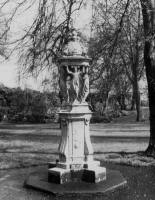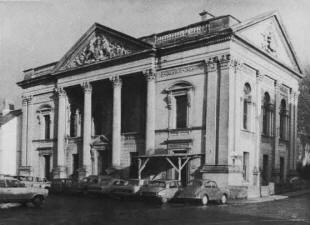
- Front Page
- Foreword
- Acknowledgements
- Contents
- The Celebration Of Nuptials
- Terminal Diseases In The Parish Of Derriaghy
- Drumbeg 1800-1860
- The Lisburn Workhouse During The Famine
- George Rawdon's Lisburn
- The Lisburn Area In The Early Christian Period Part 2: Some People And Places
- Bygone Days
- Aghalee Local History Study Group
- Wallace Fountain
- Lisburn Courthouse
- Historical Journals
Important New Acquisition for Lisburn Museum
A Bust of James Corry Jun., Secretary of Irish Linen Board, by Thomas Kirk R.H.A.
Brian Mackey
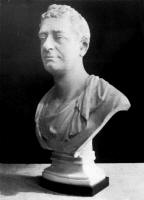 |
| Fig. 1. Thomas Kirk, James Corry Jun., white marble 69 x 44 cm. (Collection Lisburn Museum). |
The bust of James Corry Jun. (fig. 1), sculpted in white marble by Thomas Kirk in 1826 and exhibited at the Royal Hibernian Academy, Dublin in the same year, is an important new acquisition for Lisburn Museum's collection of objects relating to the Irish linen industry.1
Corry Jun. was born in 1772.2 His father, James Corry, of Lurgan Street, Dublin, was appointed secretary to the Irish Linen Board in 1777, through the patronage of John, Foster, Speaker of the Irish parliament. The position of secretary was a powerful one, as the Linen Board had no permanent chairman or executive committee and most of its members attended very infrequently.3 The Board, or to give its members their full title, the Trustees of the Linen and Hempen Manufactures of Ireland, had been established in 1711 by act of parliament, to regulate and promote the linen industry. It succeeded the trustees appointed by William III, who had employed the Lisburn-based Huguenot Louis Crommelin to act as overseer but whose enterprise was seen by a parliamentary committee in 1709 as `not fully to have answered the end' intended .4
Corry Jun. was the fifth secretary of the Linen Board, having been appointed joint secretary with his father in 1790, while still a scholar at Trinity College, Dublin. His appointment was nominal and was designed to ensure that when his father died he would succeed him, as in fact happened in January
17965 He remained in office until the Board was abolished in 1828 and was widely regarded as an honest, conscientious man of ability, who wielded considerable power for the industry's benefit and not for his own self-interest.6 Corry's probity, in fact, was exceptional, at a time when
misappropriation and the taking of `fees' were not uncommon in official life.' He produced two reports, in 1817 and 1822, which give an invaluable contemporary view of the linen industry in Ulster and show his positive contribution to the management of the
industry.8 In 1816 he toured Ulster, for his report published in the following year, and while in Lisburn, for example, visited the Brown Linen Hall, which had then one of the biggest sales of unbleached linen in Ireland. During his stay he also saw the new Jacquard hand-looms in William Coulson's Manufactory, for which the Board had given a grant of
£1,000.9
![]()
Much to his credit, he made no attempt to cling to office when the Board had outlived its usefulness. A few months before its dissolution in 1828 he wrote: `That the prosperity of the linen manufacture of Ireland has been greatly advanced by the wisdom of the laws that have governed it cannot be denied; but there is a popular opinion now abroad in which I feel that I participate, that, after a certain point of prosperity has been attained, the less any manufacture is encumbered with legislative regulations the better.10 Corry retired to Cheltenham in 1829 and lived there until 1837. His movements thereafter and the date of his death are unknown. Details of his personal life are equally obscure; in 1796 he married Maria Sherrard, daughter of a Dublin surveyor but whether he and his wife had children is also not known.
Kirk's bust of Corry, executed on the thirtieth anniversary of the latter's sole occupancy of the secretaryship of the Board, may have been commissioned to celebrate the occasion. Corry was fifty-four years old at the time. The bust reveals a distinguished man with a gracious benevolent demeanour. The piece is a masterly example of neo-classical portraiture and a work of considerable presence.
Kirk (1781-1845) was arguably the foremost sculptor in Ireland during the first half of the nineteenth century. Born in Cork, he studied at the Dublin Society's schools where he won prizes in 1797 and 1800. He had a prolific career and executed numerous statues for public monuments; also portrait busts of leading Irish peers, ecclesiastics and public figures. His statue of Nelson for the column in Sackville, now O'Connell, Street (the statue, a well-known Dublin landmark, was blown up in 1966) was one of his earliest commissions and established his reputation."
An appropriate sculpture by Kirk would be a desirable item for any Irish museum. Lisburn Museum is indebted to the National Art-Collections Fund in particular, and also to the National Heritage Memorial Fund, for generously assisting with the purchase of this fine example of Irish nee-classical sculpture, which is of special relevance to the Irish linen industry.
References
| 1. | The bust was purchased in April 1990 from the Bell Gallery, Belfast. with principal tarot aid from the NACF and subsidiary assistance from the NHMF |
| 2. | For many of the biographical details, I ma particularly indebted to Mr. H. D. Gribben, author of a forthcoming book on the Irish Linen Board. |
| 3. | A. P. W. Malcomson John Foster :The Politics of the Anglo Irish Ascendancy, 1978. pp. 271, 278. |
| 4. | W. H. Crawford, `The Huguenots and the Linen lndustry', The Huguenots and Ulster 1685-l985, exhibition catalogue, Lisburn Museum, 1985. |
| 5. | Corry, Sen. died in December 1795. |
| 6. | C. Gill, The Rise of the Irish Linen Industry, 1925, p. 301. |
| 7. | Malcomsom op. cit., p. 443. Curry Sen. defrauded the Board of some �13,000; Curry Jun., however, made a complete restitution. |
| 8. | Report of a tour of inspection through the Province of Ulster in Oct., Nov,, and Dec., 1816, 1817; Report an the measuring and Stamping of brown linen in Ulster, 1822. |
| 9. | J. Horner, The Linen trade of Europe during the Spinning Wheel period, 1920, devotes a chapter to Corry's report (xiii, pp. 147 -174). |
| 10. | Gill, op, cit., p. 307. |
| 11. | H. Potterton, Irish Church Monuments 1570-1880 1975; W.G. Stricklaad, A Dictionary of Irish Artists. 1913, which is particularly useful for a list of Kirk's commissions. |
Brian Mackey is Curator of Lisburn Museum.
![]()
NEW CASTS OF BUSTS OF RICHARD, FOURTH MARQUESS OF HERTFORD,
SIR RICHARD AND LADY WALLACE
FOR LISBURN MUSEUM.
Brian Mackey
In commemoration of the centenary of the death of Sir Richard Wallace in 1890, Lisburn Museum has, by kind permission of the Trustees of the Wallace Collection, Manchester Square, London, commissioned casts of the busts of Richard, fourth Marquess of Hertford, K.G., Sir Richard and Lady Wallace. The moulds have been made and the busts cast by Mr. Rupert Harris, London, in a waxed and polished resin marble. All three busts are of a uniform size, being 78 cm high. They are an important addition to the museum's collection and will have pride of place in the exhibition Sir Richard Wallace, Baronet M.P., held in Lisburn Museum from 6 November 1990 to 30 April 1991.
Richard Wallace (1818-90), illegitimate son of the fourth Marquess of Hertford, inherited his father's unentailed property in 1870, which included not only the 60,000 acre south Antrim, Hertford estate but a great art collection subsequently bequeathed to the nation by Lady Wallace in 1897. He acquired a European reputation as a philanthropist at the time he was besieged in Paris during the Franco-Prussian War and in recognition of this was awarded a baronetcy in 1871.1 'Received in Lisburn with great festivity on his first visit to the town in 1873 and elected unopposed as a Conservative M.P. for the borough, Sir Richard was a generous benefactor of the town until his death in July 1890.2
References
| 1. | J. F. Burns, 'The Life and Work of Sir Richard Wallace Bart. MP,' this journal, vol. 3, 1980. |
| 2. | H. Dixon 'so Many Proofs'! Aspects of the Legacy of Sir Richard Wallace in the fabric of Lisburn; this journal, vol.4, December 1982. |
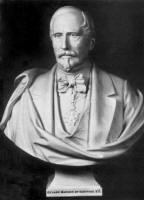 |
RICHARD, FOURTH MARQUESS OF HERTFORD, K.G. (1800-70) By Charles Auguste Lebourg (1829-1906) A posthumous bust (1872) in white marble based on a photograph by Etienne Corjat of 1855 and signed C. Lebourg. It shows the Marquess wearing evening dress with the grand cross of the Legion of Honour at his neck and the star and riband of the Garter on his chest. Lebourg was born at Nantes and studied under Francois Rude (1784-1855). He worked in Paris and was a regular exhibitor of portrait busts and statuary groups at the salon, from which he received the medaille unique in 1868. The celebrated Wallace fountains in Paris and Lisburn were designed by him in 1872. |
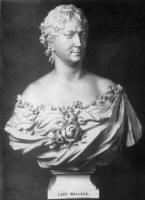 |
LADY WALLACE (1819-97)
By Charles Auguste Lebourg (1829-1906) A white marble bust exhibited at the Paris salon in May 1872, signed CH. Lebourg. It shows Lady Wallace wearing evening dress, the lower part of which is draped with a cloak, with a rose pinned in front. |
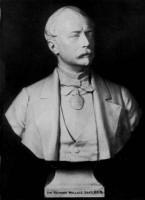 |
SIR RICHARD WALLACE BART., K.C.B. (1818-90) By Emmanuel Hannaux (b.1855) A posthumous bust of 1899 in white marble, presented to the Wallace collection by John Murray Scott in 1900, signed E. Hannaux. Wallace is wearing evening dress with the cross of the Bath around his neck and the star on his breast. Hannaux was born in Metz in 1855, worked in Paris and exhibited in the salon, where he received a first class medal in 1894. He was appointed a Chevalier of the Legion of Honour in 1900. |
The Wallace Fountain
Lisburn Court House

